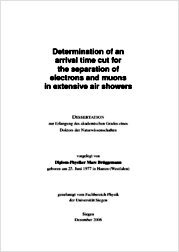Determination of an arrival time cut for the separation of electrons and muons in extensive air showers
Brüggemann, Marc
Univ. Siegen
Monografie
Verlagsversion
Englisch
Brüggemann, Marc, 2006: Determination of an arrival time cut for the separation of electrons and muons in extensive air showers. Univ. Siegen, 162 S., DOI: 10.23689/fidgeo-342.
 |
Dokument öffnen: |
Extensive air showers measured by the KASCADE-Grande experiment at the Forschungszentrum Karlsruhe are studied with respect to the arrival times of electrons and muons at observation level. KASCADE-Grande is a ground based detector array to study extensive air showers generated by primary cosmic ray particles in the energy range from 10^14 eV to 10^18 eV. Approximately 290,000 air showers measured between January 2005 and Febuary 2006 are used to generate arrival time distributions of electrons and muons for 13 intervals of the distance R to the shower center. The particle arrival times are reconstructed by unfolding detector signal pulses sampled by a Flash-ADC based data acquisition system connected to the electron and muon detectors of eight detector stations of the KASCADE detector array. For distances R>200 m particles of the a muonic shower component arrive on average earlier at observation level than particles of the electromagnetic shower component. This difference in arrival time is used to determine a cut on the particle arrival time as a function of the distance from the shower center. This cut is intended to be used by experiments with time resolving detectors for the separation of electrons and muons according to their arrival times relative to the arrival time of the shower core. Particles with arrival times smaller than the cut are considered as muons. Due to the large spread of the arrival time distributions the number of muons reconstructed in this way will contain a contribution from the electromagnetic shower component ...

